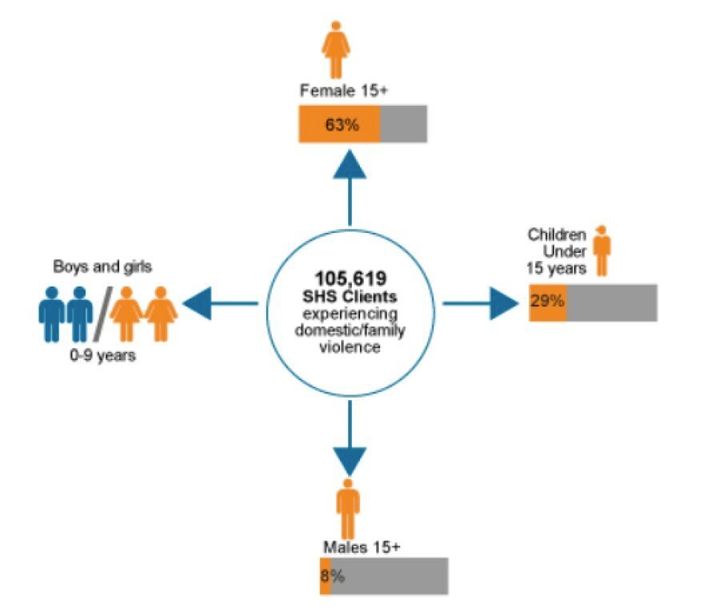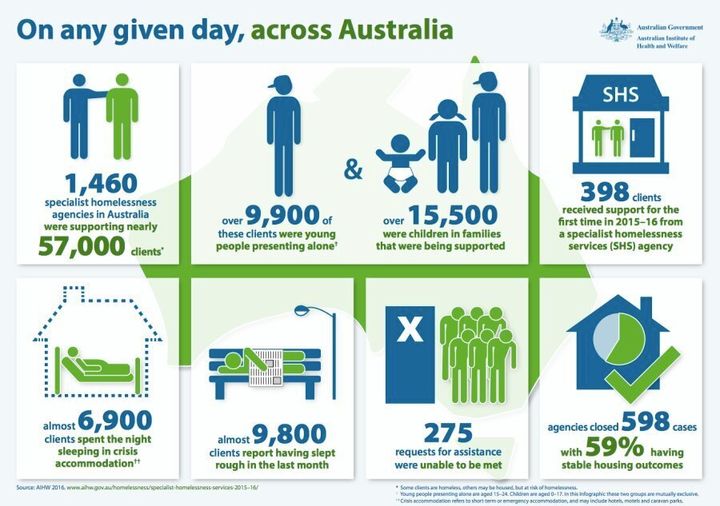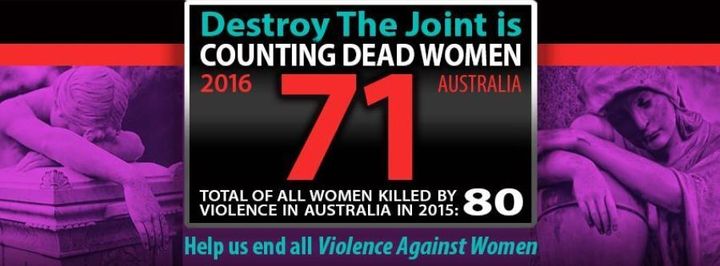
On more than one occasion in 2016, staff at South West Sydney's Bonnie Support Services have had to tell women fleeing homelessness and domestic violence that they're at capacity, full-up.
"We've had to say we just can't see anybody," BSS executive Officer Tracy Phillips told The Huffington Post Australia, explaining that the operation provides support for 1500 people a year.
"That generally only lasts a few weeks, and we keep pushing through -- but, you know, there's no doubt that for whatever reason, the demand is greater."
Australia has seen a surge in homelessness in 2015-16, boosted in part by rapid growth in the number of women fleeing domestic and family violence. The number of Australians accessing homelessness services hit a record 279,000, up from nearly 256,000 the year before.
Of those, a total of 106,000 sought help due to domestic and family violence, a year-on-year increase of 14 percent, and up 33 percent since 2011-12.
"It's right across the country, that we're challenged," Mission Australia CEO Catherine Yeomans told The Huffington Post Australia.
Put simply, these problems don't occur in isolation. Domestic violence victims make up an increasing percentage of homeless Australians; the housing bubble makes it more difficult for women to escape domestic abuse and set up a home elsewhere; and there are more people sleeping rough because they can't afford property. One crisis affects the other, and vice versa.
"We have not provided enough infrastructure investment in housing, as a country. It really needs federal government leadership, because it is truly a national issue," Yeomans said.
If we're going to solve this, nationally, then we need to be working together, it has to be a priority, it has to be led by the Federal government and it has to be supported by State and Territories.Catherine Yeomans
Nearly half of those seeking homelessness services because of family violence in 2015-16 were single parents with at least one child. They face huge barriers to getting affordable homes while trying to escape the trauma of a violent domestic relationship.
"Women are competing with people who are employed, couples who are employed, so a single woman who is leaving family or domestic violence, there are so many other people from a commercial point of view that a real estate agent is going to offer a property to before that person," said Phillips, whose Bonnie Support services helps women find temporary homes.
In 2015-16 specialist homelessness services agencies assisted 106,000 domestic and family violence clients:
- 13,300 — 14 percent more clients sought assistance for domestic and family violence when compared to 2014-15
- The growth was largely due to increases in New South Wales (over 5,800 clients), Victoria (around 4,300 clients) and Western Australia (almost 1,300) over the past year.
- Over three-quarters (77 percent) of domestic and family violence clients were female.
- Nearly half of all clients (47 percent) seeking assistance for domestic and family violence were living in single parent households (with a child or children), unchanged from the previous year.
- 62 percent were at risk of homelessness when first presenting for support, similar to the previous year (63 percent).

Both social and public housing are in very high demand in NSW, where modest improvements in supply have seen what Phillips termed "some good outcomes" on the local level over the past year.
"But nonetheless the shortfall is huge," she said, pointing out the wait for public housing can take 13 to 15 years for people who are just on the general waiting list for public housing, and not a priority list.
"The wait is very long and the supply and demand just don't meet up," said Phillips.

Yeomans said a significant problem in the homelessness sector is the lack of long-term planning by Federal Governments. For the past five years they have provided funding to the homelessness care providers through partnerships.
Last week, the federal government extended the National Partnership Agreement On Homelessness (NPAH) for another year, allocating $117 million to the fund which will be matched by state and territory governments until June 2018. NPAH funds 180 services and supports 80,000,
The announcement came after a community based campaign that drew in 200 organisations and 40,000 people to lobby the government. Over the past five years there have been two rounds of one year extensions, then a two year extension, and most recently another one year.
Key trends identified by the AIHW over the 5 years since 2011-12:
- Nationally, the number of clients who had experienced domestic and family violence and sought assistance from specialist homelessness agencies has increased on average 7 percent each year since 2011-12.
- All jurisdictions had increases, with Tasmanian Specialist Homeless Service agencies experiencing the highest average annual growth of domestic and family violence clients (15 percent each year) but Victoria contributed the most in terms of numbers of clients.
- The proportion of clients who were homeless upon presentation has increased, from 33 percent in 2011-12 to 38 percent in 2015-16.
- The proportion ending support with improved housing outcomes has increased, particularly for those in private rental or home owners (up around 5 percent to 47 percent in 2015-16).
Source: AIHW
"(The lack of planning) is a very significant problem," said Yeomans.
"We've heard for a number of years now that the rational for the short term funding... and every time an extension is communicated, it's always a long-sighted statement that the Federal government wants to work with state governments to review how the funding operates.
"They've had five years to work that out, another 12 month extension doesn't leave us or the sector that the review is going to occur in that 12 month period, unless there is, under Federal Government Leadership, a commitment to a plan with a time table and key milestones along the way."
(Yeomans also cited recent reports of the government-led inquiry into housing affordability in Australia, which after two years, 65 submissions and 68 witnesses offered zero recommendations for tackling the problem.)
The battle for Domestic Violence Leave
- The premiers of Victoria and Queensland are pushing for a national agreement on a national paid domestic violence leave scheme, but state leaders delayed making a decision when they met with the Prime Minister in Canberra on Friday.
- Experts are pushing for millions of workers to get 10 domestic violence leave days each year in a case before the Fair Work Commission.
- Finance minister Mathias Cormann warned it would be 'another cost' to the economy.
By June 2018, little will have changed for women fleeing violent home lives for other uncertain and unsafe futures.
"We know that in two years time we will not have addressed domestic violence sufficiently for it to have gone away," said Phillips.
"So if we can be more forward thinking about those things, and it be de-politicised when the next government comes in -- if they have a plan there that they can follow, that would be a really good thing.
